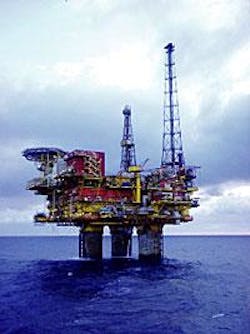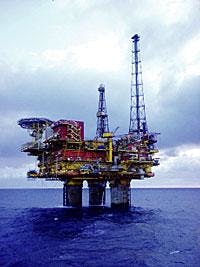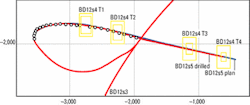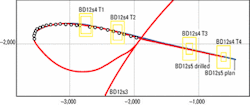Pioneering a slimhole rotary steerable system in the North Sea
Klaas van der Plas
Chris Kuyken
Shell Expro
Mike Williams
Schlumberger Oilfield Services
The first commercial application of a 4.75-in. slimhole rotary steerable system in the North Sea has opened the door to a slimhole well revolution. The location was the Shell Expro Brent field on the UK continental shelf (UKCS). The Brent Delta BD12S5 well was directionally drilled in April. Following the success of this well, plans are to make additional runs with the newly developed and smallest member of the Schlumberger PowerDrive system.
The success of the slimhole rotary steerable system is particularly important for the cost-conscious mature areas of the North Sea, where being able to tap ever-smaller pockets of oil and gas has become the name of the sustainability game. But 6-in. wells drilled with efficient rotary steerable systems offer far more than straight cost savings over conventional wells. It is already evident from this pioneering North Sea success that the slimhole rotary steerable system is capable of hitting its target with great accuracy and efficiency, which means the door is firmly open to profitably access hydrocarbon pockets of less than 1 MMbbl.
Case study
In the Brent Delta well, the Power-Drive Xtra 475 rotary steerable system was fitted with Vision telemetry for transmitting data and an optimized 6 1/8- in. Hycalog RS223 six-bladed polycrystaline diamond compact (PDC) bit. The well was directionally drilled in one run, a distance of 2,377 ft. in 43.5 hours at an average rate of penetration (ROP)of 67 ft/hr from the 7 5/8-in. liner shoe to well TD. Including the need for additional circulation to control equivalent circulation density in depressurizing, Brent and the entire operation associated with drilling the 6 1/8-in. section resulted in only 5.02 days.
The interval penetrated started in the Heather at 10,868 ft at 75° inclination and 96° azimuth, and extended through the Brent West Flank reservoir to 13,245 ft at 84° inclination and 102° azimuth. Other drilling parameters for the well were 3,500 psi surface pressure at 250 gpm, with 570 psi per thousand ft oil-based mud, and 8,000 to 12,000 ft-lb surface torque at 120 rpm. The bit was run at around 3,000 to 7,000 lb.
The Shell Brent Delta team had originally intended to use a different rotary assembly and variable gauge stabilizer to achieve the required gentle angle build. Offset data indicated an average ROP of 45 ft/hr. A rotary assembly had to be used because it is not possible to use positive displacement motors due to the severe sticking problems in the reservoir section of the heavily depressurized Brent field.
It was accepted that the original rotary system could not achieve the required azimuth change. The team decided to switch to this technology, based on prior experience with larger members of the rotary steerable system. The well was considered a suitable candidate, even though the slimhole system was commercially untried and difficulties on the previous 7 5/8-in. section meant that the well path was not quite as aligned as it should have been.
The system coped easily with the directional work, achieving 6$#176; doglegs and average ROPs of 33 ft/hr initially, which increased to 70 ft/hr by the end of the section. A steering response of only 70% of the total tool power setting was experienced. The job was completed in a single run instead of several.
Conventional drilling disadvantages
The new system saved 8.42 days on the time taken to drill a typical 6 1/8-in. section. The conventional solution would involve a separate trip with a positive-displacement motor that typically in these formations and tortuosities would struggle in slide mode to accomplish the required turn. Even based on this one application, the conclusion was that the slimhole rotary steerable system was capable of coping with the most demanding of reservoir profiles in a single run, and that a well could be designed with a 6-in. hole as the primary reservoir section.
As indicated, this has major implications in a mature province like the North Sea where the emphasis is now on extending field life, and containing costs is paramount. It was realized in 1999 that 6-in. (and, in the future, smaller) slimhole sidetracks drilled with rotary steerable technology offered that possibility and that its use could overcome disadvantages associated with conventional drilling technologies.
When working over a well with a 9 5/8-in. casing and 7-in. or 7 5/8-in. liner with a view to side tracking, the convention is to first pull out a casing string cemented in earlier. But, if it were possible to leave the existing casing strings in the well and build from that, then part of the wellbore architecture would already be in place. Until now, where 6-in. holes have been drilled, they have been as contingency, rather than primary sections. A 6-in. slimhole can now be utilized as the primary hole section; this being so, it will no longer be necessary to recover previous casing strings.
Shell took an aggressive approach to this by sticking to a prototype system that had only been tested at a full-scale facility at Rogaland, Norway, into a very expensive well. There was a clear business case for the technology, though there was obviously risk attached to the untried technology.
Future plans
Shell debated the choice to test the system in the Brent field or take it to the Middle East for trials. The North Sea had the twin advantages of international cachet, plus it was a high-cost environment. Success there should readily pave the way to success elsewhere. The team pushed hard to get it in the ground in the North Sea because they wanted to start a North Sea track record.
A significant number of UKCS wells were planned based on conventional technology, but the team believes that the majority can be redesigned to 6 in. and drilled with rotary steerable technologies with significant cost savings. The great change would be the ability to easily drill targets that would be hard to reach or unattainable with conventional technologies.
The Brent well trajectory was drilled in the shoe-to-shoe mode, which is optimum, whereas many conventional technologies may involve a couple of trips. The next test will involve a more challenging well track to see if the system can achieve shoe-to-shoe again.
Currently, the tool is drilling a 6 1/8-in. hole section in a well on the Brent Charlie platform.
The potential for cost savings is considerable, especially when designing a well from the bottom up, starting with 6-in. casing hole. A further benefit is that drilling with rotary steerable systems results in a much cleaner wellbore. The cost of drilling a typical conventional well is currently about $5.7 million.
Apparently, slimhole wells using rotary steerable systems as an alternative to a downhole motor is the way to go. Cutting well costs and slimming down wells are the best solutions for optimizing existing assets. Used in conjunction with real-time drilling and geological data, the system offers a distinct advantage to oil and gas operators to reduce well construction costs.
null
null
null




